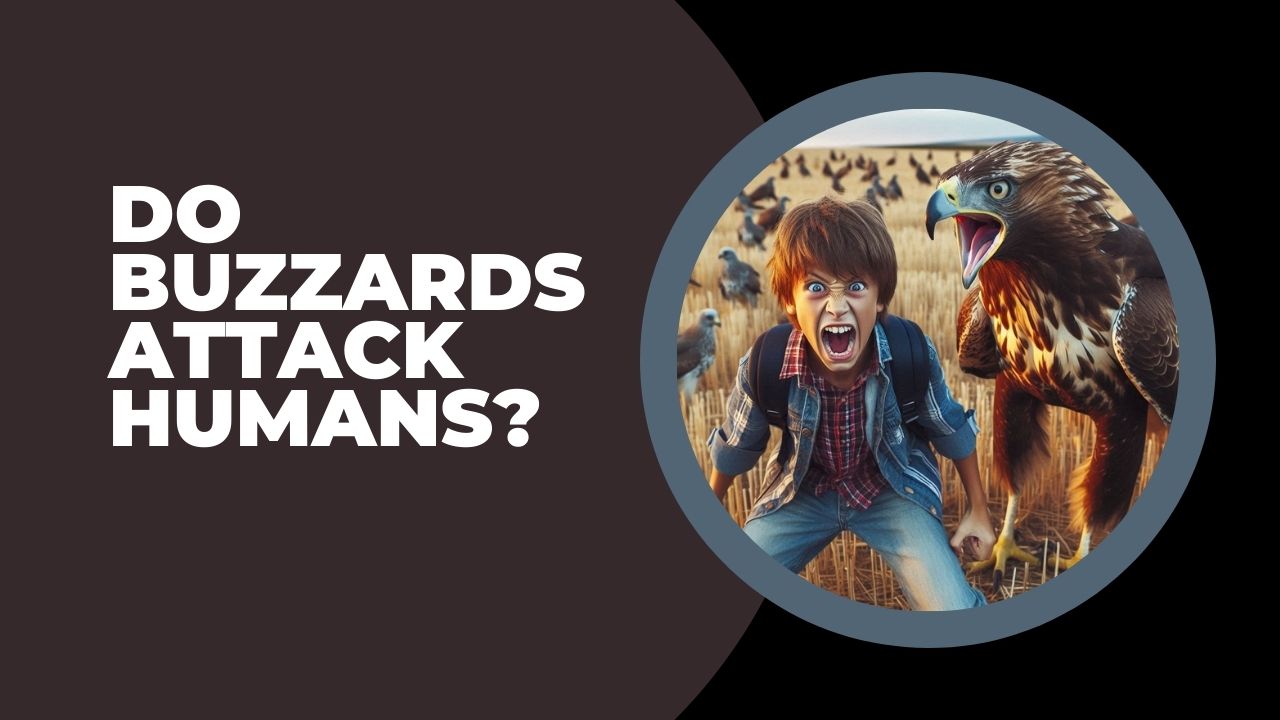Do Buzzards Attack Humans? Buzzards generally avoid humans and rarely attack, but they may exhibit defensive behavior if they feel their nests or young are threatened.
Buzzards are often misunderstood birds of prey, sometimes feared due to their large size and predatory appearance.
However, despite their intimidating look and powerful talons, buzzards are generally shy creatures that prefer to avoid humans.
In this article, we’ll delve into the world of buzzards, exploring their behaviors, why they might seem aggressive under certain circumstances, and tips on what to do if you encounter one.
We’ll also provide insights into how buzzards compare with other birds of prey and address some common misconceptions surrounding these birds.
Contents
Understanding Buzzards
What Are Buzzards?
Buzzards are a type of bird of prey belonging to the genus Buteo, often characterized by broad wings, strong talons, and a curved beak. [Do Buzzards Attack Humans?]
They’re typically found in North America, Europe, and parts of Asia, where they thrive in various environments, from woodlands and fields to mountainous regions.
Buzzards are medium to large birds with a wingspan that can reach over 4 feet, making them powerful flyers well-equipped for hunting.
Unlike many other raptors, buzzards are often opportunistic feeders, meaning they will scavenge for food rather than strictly hunt.
This behavior plays a vital role in ecosystems, as it helps remove carrion and control populations of smaller animals. Buzzards are typically solitary or seen in pairs, particularly during the breeding season.
Buzzard Behavior Around Humans
Despite their imposing appearance, buzzards are not naturally inclined to interact with or harm humans. In fact, most buzzards avoid human activity and seek areas with minimal disturbance.
However, as urbanization expands into their natural habitats, occasional encounters with buzzards have become more common. [Do Buzzards Attack Humans?]
When spotted near populated areas, it is usually because they are foraging for food rather than looking for confrontation.
Buzzards are known for their soaring flight patterns, often circling high in the sky while searching for food.
These circling patterns, combined with their association with scavenging, can give the impression that they’re “hunting,” which can contribute to misunderstandings about their intentions.
For the most part, buzzards are disinterested in humans and pose little to no threat. [Do Buzzards Attack Humans?]
Why Would Buzzards Attack?
Natural Instincts and Defense Mechanisms
Buzzards, like many other wild animals, have innate defense mechanisms that may prompt them to appear aggressive.
During the nesting season, buzzards become highly protective of their young and their territory.
This season generally lasts from March through August, during which buzzards build nests in tall trees, cliffs, or other elevated locations that provide a clear view of the surroundings.
They will often defend these areas if they perceive a threat to their offspring. [Do Buzzards Attack Humans?]
In some cases, if a person unknowingly approaches a buzzard’s nest, the bird may exhibit defensive behavior. This might include loud vocalizations, swooping, or circling.
Such behavior is more of a warning and typically doesn’t escalate to physical contact. Buzzards are generally not aggressive predators but are instinctively driven to protect their young.
Situations That May Trigger Aggression
While it’s rare, certain situations may provoke defensive behavior in buzzards. Encounters where a person or animal comes close to a buzzard’s nest are the most common triggers for aggression.
During the breeding season, even well-meaning hikers, birdwatchers, or outdoor enthusiasts can inadvertently venture into nesting territories, prompting a protective response.
Another situation that might provoke a reaction is when buzzards feel cornered or trapped, such as if one lands near a human and perceives no escape route.
However, such cases are highly unusual as buzzards generally maintain a comfortable distance and prefer open areas where they can easily fly away if disturbed.

Are Buzzard Attacks on Humans Common?
Documented Cases of Buzzard Attacks
Reports of buzzards physically attacking humans are exceedingly rare. [Do Buzzards Attack Humans?]
In most cases, “attacks” are more accurately described as defensive swoops or close passes that are intended to scare off intruders rather than cause harm.
Buzzards lack the predatory drive to see humans as prey and instead view people as potential threats when their nests or young are nearby.
In a few documented instances, hikers and birdwatchers have reported “dive-bombing” behavior from buzzards, especially in the spring and early summer when the birds are raising their young.
During these encounters, the buzzard may fly close or issue warning calls to signal its presence. However, it’s essential to remember that the purpose of these displays is deterrence, not harm.
Comparing Buzzards with Other Birds of Prey
Compared to other birds of prey, buzzards are generally more reserved. [Do Buzzards Attack Humans?]
Species like hawks and owls are known to exhibit aggressive behavior when defending nests, sometimes even making contact if they feel particularly threatened.
Owls, for example, are highly territorial during breeding season and may “dive-bomb” intruders at night.
Buzzards, on the other hand, tend to be more cautious and avoid interactions unless absolutely necessary. Even if they do feel threatened, buzzards are more likely to make noise or swoop close rather than engage directly.
Their preference for scavenging over hunting also plays a role in this tendency, as they are not inclined to perceive humans as threats or prey in the same way other raptors might.
What to Do if You Encounter a Buzzard
Tips for Staying Safe Around Buzzards
If you find yourself near a buzzard in the wild or notice one circling overhead, here are a few safety tips to follow:
- Maintain a Respectful Distance: Buzzards, like many wild animals, value their space. If you see a buzzard up close, keep your distance, especially if you suspect a nest may be nearby. [Do Buzzards Attack Humans?]
- Avoid Nesting Areas During Breeding Season: The nesting season can make buzzards more defensive. If you’re hiking or exploring during spring or summer, stay aware of signs that indicate bird nesting areas, and keep to designated trails.
- Stay Calm and Avoid Sudden Movements: Sudden movements can alarm a buzzard. If a buzzard swoops or circles near you, stay calm, avoid making direct eye contact, and back away slowly. Most of the time, the bird will retreat once it feels the potential threat has passed.
Protecting Yourself and the Environment
Respecting wildlife, including birds of prey like buzzards, is critical for maintaining a healthy ecosystem. Buzzards play an important ecological role by scavenging, which helps control waste and disease.
Avoid approaching nests, especially during the breeding season, and support conservation efforts to protect their habitats.
As urbanization encroaches on wild spaces, respecting the natural behaviors of these birds allows us to coexist peacefully. [Do Buzzards Attack Humans?]f
See Also: Do Moths Attack Humans? The Truth!
Common Misconceptions About Buzzards
Buzzards are often associated with negative myths and misconceptions. Some people mistakenly view them as aggressive or as “harbingers” of death, largely due to their role as scavengers.
However, these ideas are unfounded and based more on cultural stereotypes than facts.
- Myth: Buzzards are dangerous predators. [Do Buzzards Attack Humans?]
Fact: Buzzards are primarily scavengers and rarely hunt live prey. They feed on carrion and small animals, contributing positively to the environment by cleaning up dead animals. - Myth: Buzzards attack people regularly.
Fact: Buzzards avoid humans and only display defensive behavior if their nests are threatened. Actual attacks are extremely rare. - Myth: Buzzards circling overhead mean they’re about to attack.
Fact: Buzzards circle to scan the ground for food, not to “target” humans or animals.
FAQs
Are Buzzards Dangerous to Pets?
Buzzards rarely pose a threat to pets, especially larger animals. They are more inclined to scavenge than to hunt live animals. However, very small pets should still be supervised in areas where birds of prey are common, as other raptors like hawks may be more of a concern. [Do Buzzards Attack Humans?]
What Should I Do if I See a Buzzard in My Yard?
If you see a buzzard in your yard, it is likely passing through in search of food. Avoid approaching it, and it will usually move on quickly. Buzzards generally don’t linger in populated areas unless there is an abundant food source.
How Can I Tell if a Buzzard Is Agitated or Defensive?
Signs of agitation in buzzards include loud vocalizations, circling, or swooping. These are typically warning behaviors, intended to encourage intruders to move away from nesting sites. Backing away slowly and calmly is the best course of action.
Are There Other Birds That May Attack Humans More Frequently Than Buzzards?
Yes, certain hawks, eagles, and owls are more likely to engage in defensive behavior, especially during breeding season. Buzzards are relatively non-aggressive compared to these species.
Do Buzzards Carry Diseases That Could Harm Humans?
As scavengers, buzzards may come into contact with pathogens, but the risk of disease transmission to humans is minimal. Avoid direct contact, and do not handle dead animals that may have been scavenged.
Final Verdict
Buzzards are generally non-aggressive birds that play a vital role in maintaining ecological balance. [Do Buzzards Attack Humans?]
While they may exhibit defensive behavior during nesting season, attacks on humans are exceedingly rare.
By respecting their space and understanding their natural behaviors, we can coexist with these birds without conflict.
Conclusion: Do Buzzards Attack Humans?
Buzzards are fascinating birds that often suffer from cultural misunderstandings. Despite their imposing appearance, they are cautious creatures that avoid conflict.
Observing them from a respectful distance and appreciating their role as nature’s clean-up crew allows us to better appreciate these magnificent birds.
By fostering respect for buzzards and their habitat, we contribute to preserving biodiversity and maintaining a balanced ecosystem.

Hello, I am Rosa Ellis, a mother of two and a wildlife blogger. I grew up in New York City, but I love exploring forests. I’ve traveled to places like Yellowstone National Park and the Amazon Rainforest to see animals up close. I know a lot about animal behavior and which animals can be dangerous to humans. Thanks for visiting my blog!

